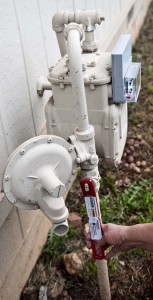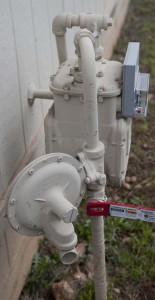In case of an earthquake, fire, or gas leak it is important that you know how to turn off the natural gas at the meter. First know where your gas meter is located. If you live in an apartment there may be several meters, find out before hand which is yours. Do not shut off the gas unless you smell gas, hear gas escaping, or see a broken gas line or if you suspect a gas leak.
It is really pretty simple to turn the gas off. There is a valve on the pipe coming into the meter that takes a quarter turn to shut it off. The gas is turned off when the tang, the part you put the wrench on is in the crossways position. I keep a wrench attached to the meter so that there is always one available. A 10 – 12 inch crescent wrench is adequate.
 Once the gas is turned off, do not turn it back on yourselves, without repairing the damage and having a safety inspection by a quality technician. When the gas is back on be sure and light all of the pilot lights. If you fail to light these correctly you may cause a fire or explosion. Your local gas company will normally respond and turn the gas on,
Once the gas is turned off, do not turn it back on yourselves, without repairing the damage and having a safety inspection by a quality technician. When the gas is back on be sure and light all of the pilot lights. If you fail to light these correctly you may cause a fire or explosion. Your local gas company will normally respond and turn the gas on, and light the pilot lights for you, at no charge
and light the pilot lights for you, at no charge
The picture on the left shows the wrench on the tang in the on position.
The picture on the right shows the wrench in the off position
The wrench shown in the pictures is one that is designed to shut off most standard gas meters, I got mine from Emergency Essentials.
Howard


I really like seeing education out there about disaster preparedness. Everyone should be taught how to turn their gas meter off. I hope a lot of people read this and are prepared just in case they need to turn their gas meter off during the next big disaster that occurs!
can gas still manage to enter your home even though the valve is shut off?
If the valve is good, no gas should enter your home, if it is shut off.
With a valve that requires lubrication at its valve core (inside the valve), and that valve has not been maintained, gas can and will bypass the valve in the off position. But if your gas appliance valves are off, and/or your alliance control valves have 100% safety’s, then it won’t be an issue. In this situation, on average, probably only .01 CFH (cubic feet per hour) will bypass. A ball valve does not require lubrication, and should completely seal off gas.
I meant appliances, not alliances. And safety, not safety’s.